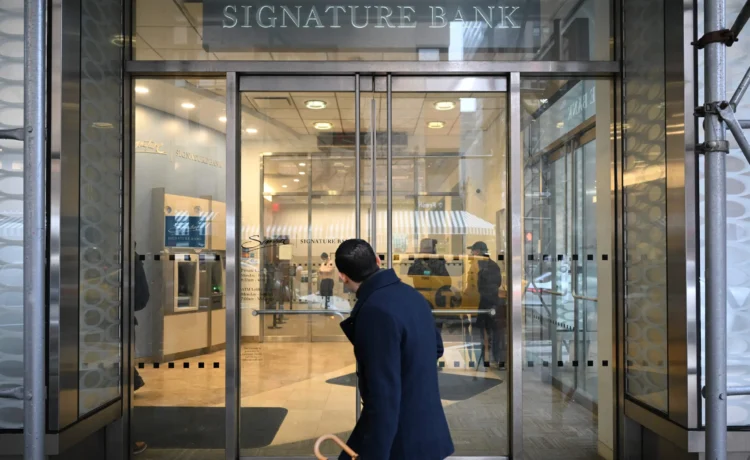Crypto may be a 24/7, 365 ecosystem, but traditional banking is not.For years, disruptors relied on two digital payment networks—Silvergate Bank’s Silvergate Exchange Network (SEN) and Signature Bank’s Signet—as on-ramps from U.S.dollars into cryptocurrencies. The groundbreaking platforms allowed crypto companies to work with fiat currency outside of traditional business hours, rather than having to rely.
Crypto may be a 24/7, 365 ecosystem, but traditional banking is not.For years, disruptors relied on two digital payment networks—Silvergate Bank’s Silvergate Exchange Network (SEN) and Signature Bank’s Signet—as on-ramps from U.S.dollars into cryptocurrencies.
The groundbreaking platforms allowed crypto companies to work with fiat currency outside of traditional business hours, rather than having to rely on restricted services like the Federal Reserve’s Fedwire or ACH transfers, and were key to the business structures of top firms such as Circle, the issuer of the stablecoin USDC.
The developing banking crisis and collapse of both Silvergate and Signature have thrown the payment rails into flux.Silvergate
shuttered SEN on March 3, before announcing its voluntary liquidation on March 8, and New York regulators took over Signature on Sunday citing “systemic risk,” effectively ending the Signet platform.
According to financial experts and industry participants, the closure of the two payment providers will create immediate liquidity problems for the crypto ecosystem—especially stablecoins, which will no longer have 24-hour on- and off-ramps into or out of U.S.dollars.
“Signet and SEN were essential,” said Nic Carter, a general partner at the crypto-focused Castle Island Ventures.
“Now we can expect more stablecoin depegs [and] more choppiness and volatility on exchanges on the weekends.”
Mints and redemptions
For Circle, SEN and Signet served as essential cogs in its well-oiled machine.Investors could trade USDC across exchanges at any time, but to actually mint or redeem USDC—the process of turning fiat currency into the crypto token, or vice versa—Circle relied on the two real-time payment platforms.
Circle’s relationship with SEN
ended on March 4, and CEO Jeremy Allaire announced on Sunday that the company would no longer be able to use Signet, instead relying on settlements through BNY Mellon.The company later said it would be using another crypto-friendly bank, Cross River, for minting and redeeming USDC, although the service would no longer be available outside business hours—at least for now.
With the closure of Signature bank announced tonight, we will not be able to process minting and redemption through SigNet, we will be relying on settlements through BNY Mellon.— Jeremy Allaire (@jerallaire)
[March 12, 2023]
“The loss of two transit-point banks, for the lack of a better way of describing them, does dampen the ability to support not just a Circle, but across the entire ecosystem,” Dante Disparte, Circle’s chief strategy officer, told Fortune.
As Carter pointed out, the lack of availability for a minting/redemption mechanic could create liquidity issues outside of business hours that could lead to stablecoins depegging, or no longer sharing the same value as their underlying asset.
Austin Campbell, the former chief risk officer at the stablecoin firm Paxos and managing partner at blockchain-focused Zero Knowledge Consulting, said the crypto industry will have to prepare for instability as participants can no longer cash out of positions outside of U.S.banking hours.
That happened to USDC over the weekend, when investors rushed to withdraw funds amid concerns over stuck reserves at
Silicon Valley Bank, and USDC’s value sunk to under 90 cents against the dollar across different exchanges.Stoking the panic, Circle also announced on Saturday that the Signet system had reached “a capacity threshold” and would not be able to process redemptions until Monday.
‘Filling the void’
Disparte said that until the banking sector creates a solution, the crypto industry will have to adjust to a new normal and “train the digital economy that there is going to be a banking-hours dependency on the fiat on- and off-ramps for crypto” in the U.S.
“Filling the void for the always-on internet scale services is going to take some time,” he added.
Solutions may be on the horizon.
The United Kingdom-based crypto firm BCB Group offers a payment service provider similar to SEN and Signet called BLINC, which operates in a handful of currencies including the euro, pound, and yen, although not yet the U.S.dollar.
BCB had planned to launch a U.S.dollar pilot, although it had to
pause the trial due to the closure of partner Signature on Sunday.
In an interview with Fortune, BCB’s Oliver von Landsberg-Sadie said that the firm built BLINC because losing access to banking and payment rails was a “business killer.”
He believes the model of BCB, which manages the payment platform without operating as a bank, could prove to be a safer and more reliable alternative to SEN and Signet.Circle is an investor in BCB, and Disparte said that BCB is “one of the institutions to watch” that could fill the void.
After the delay caused by Signature’s closure, Landsberg-Sadie said he expects the pilot to launch in about one to three months, with the goal of being able to “plug the gap as quickly as possible” left by SEN and Signet.
Despite current liquidity risks, Landsberg-Sadie said that the crypto ecosystem should be able to rely on the USDC already in issuance outside of banking hours, with market makers taking on weekend risk.
“[Circle] is going to be able to withstand a lot more than what hit them this weekend,” he told Fortune.
Fortune‘s CFO Daily newsletter is the must-read analysis every finance professional needs to get ahead.
Original source: https://crypto247.news/what-the-collapse-of-crypto-banks-could-mean-for-stablecoins/














